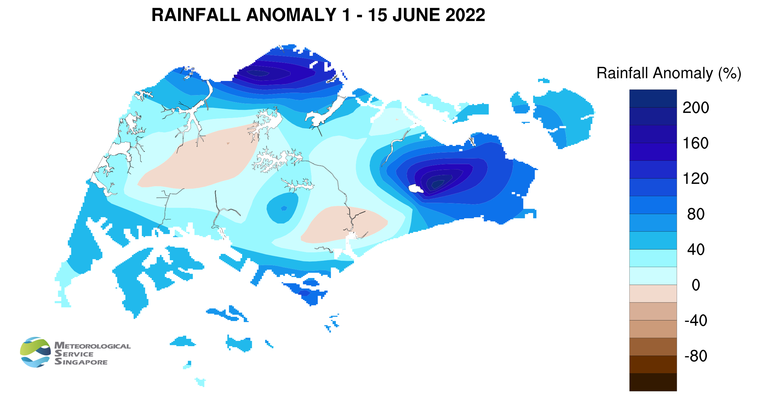Singapore, 16 June 2022 – The current wet weather is expected to continue in the second half of June 2022. During this period, thundery showers are expected on most days. The showers could bring a slight easing of the warm conditions felt in recent weeks. The prevailing Southwest Monsoon is forecast to persist for the rest of June 2022. During the coming weeks, the low-level winds over Singapore and the surrounding region are forecast to continue blowing from the southeast or southwest on most days.
2 In the second fortnight of June 2022, the monsoon rain band is likely to lie close to the Equator. This may bring more rainfall over the equatorial Southeast Asia region. The passage of Sumatra squalls are expected to bring widespread thundery showers with gusty winds to Singapore between the predawn hours and morning on some days. In addition, short-duration thundery showers are expected between the late morning and afternoon over parts of the island on several days. On some of these days, the thundery showers could be heavy, due to strong day-time heating of land areas coupled with convergence of winds over Singapore and the surrounding vicinity. Overall, the rainfall for June 2022 is forecast to be above-average over most parts of the island.
3 The wet weather expected in the second half of June 2022 may help to slightly ease the warm and humid conditions felt in recent weeks. On most days, the daily temperature is forecast to range between 24 and 33 degrees Celsius. There could still be a few warm days with daily highs exceeding 34 degrees Celsius. A few nights may be relatively warm and humid when southeast winds blow warm and moist air from the sea toward land. Night-time minimum temperatures of up to 28 degrees Celsius can be expected, particularly over the eastern and southern coastal areas of the island.
4 For updates of the daily weather forecast, please visit the MSS website (https://www.weather.gov.sg), NEA website (www.nea.gov.sg), or download the myENV app.
REVIEW (1 – 15 June 2022)
5 In the first fortnight of June 2022, Southwest Monsoon conditions prevailed over Singapore and the surrounding region. The prevailing winds blew from the southeast or south on most days, and from the southwest or west on a few days.
6 The first half of June 2022 was wetter compared to the second half of May 2022. During the first two weeks of June 2022, most of the thundery showers occurred in the afternoon due to strong solar heating of land areas. There were a few nights where moderate to heavy thundery showers fell over the island due to convergence of winds in the region. On 8 June 2022, widespread moderate to heavy thundery showers fell over the island between late afternoon and night. The daily total rainfall of 121.2mm recorded at Sentosa that day was the highest daily total for the first fortnight of June 2022.
7 The first half of June 2022 was less warm compared to May 2022 due to more days of rain. The daily maximum temperature ranged between 32 and 34 degrees Celsius on many days; and exceeded 34 degrees Celsius on a few days. The highest daily maximum temperature of 35.1 degrees Celsius was recorded at Paya Lebar on 8 June 2022.
8 Most parts of the island received above average rainfall in the first fortnight of June 2022. The highest anomaly of 223% above average was recorded at Simei. The anomaly was lowest at Bukit Panjang at 21% below average.
CLIMATE STATION STATISTICS
Long-term Statistics for June
(Climatological reference period: 1991 – 2020)
| Average daily maximum temperature: | 31.9 °C |
| Average daily minimum temperature: | 25.7 °C |
| Average monthly temperature: | 28.5 °C |
| Average rainfall: | 135.3 mm |
| Average number of rain days: | 13 |
Historical Extremes for June
(Rainfall since 1869 and temperature since 1929)
| Highest monthly mean daily maximum temperature: | 33.2 °C (1997) |
| Lowest monthly mean daily minimum temperature: | 23.2 °C (1965) |
| Highest monthly rainfall ever recorded: | 378.7 mm (1954) |
| Lowest monthly rainfall ever recorded: | 21.8 mm (2009) |

